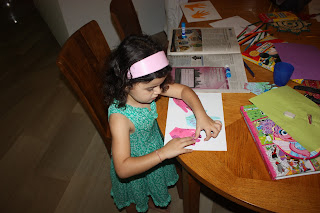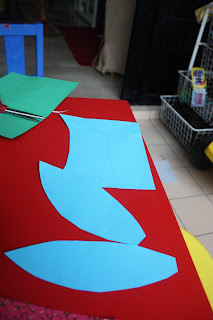Deepavali - or
Diwali - is just around the corner. Your kids may be learning about it in school, or at least know that it's a public holiday here in Singapore.
I had a couple of friends ask for our recommendations for a Diwali tour of Little India with their kids, so I thought I would share it here for local readers. We visit Little India on an almost weekly basis and especially enjoy it during this festive time.
Be prepared for it to be more crowded than most other places in
Singapore and for the traffic laws to be a little bit looser - but that's part of the experience. Almost like India
itself!
I would recommend going around 5:30 or 6:00pm. You can see the market and have dinner before it gets dark and then see the lights as it gets dark around 7:00 before heading back home to put the kids to sleep.
First Stop: The Diwali Bazaar on Campbell Street.
The market is off of Serangoon Road, just opposite of Tekka Market. The street is closed down so you don't have to worry about cars.
Here you'll
find all sorts of colorful Indian goodies: wall hangings,
rangoli stickers, crunchy Indian snacks, Hindu idols, bangle bracelets, peacock feathers, diya candles, and more! There are also a number of mehndi artists. You can pick your design from a book they have. For kids, it won't be more than a few dollars.
 |
| shop selling items used for puja (prayer ceremony) |
 |
| all sorts of colorful goodies from India |
 |
| mehndi/henna artists |
 |
| diyas (claypot candles) are traditionally placed around the house for Diwali; they come in all shapes and sizes and are filled with oil and a string and then lit |
Second Stop: Dinner at Ananda Bhavan, a South Indian restaurant at 58 Serangoon Road.
When you're leaving the Diwali Bazaar, turn right on Serangoon Road and the restaurant is just up the street on the right side.
The Whirl Girl's favorite is Plain Thosai, a slightly sourdough-y crispy crepe-like treat made from rice and daal (lentil) flours. It is served, like most of the other South Indian foods, with 3 chutneys (coconut, tomato and one other) and a spicy vegetable stew called sambhar. The thosai itself isn't spicy.
Our other favorites:
- Masala Thosai (same as the above, but with spicy potatoes in the middle) or Rava Masala Thosai (made with semolina flour);
- Oothapam, which is kind of like a savory pancake, but thicker and made from a
different batter than dosa
- Appam, which has a little sweet taste to it,
and is served with orange sugar and coconut milk. You can also request a spicy coconut-milk based spicy stew called kuruma instead (recommended!).
- Thali, a big
pile of rice and a bunch of different indian vegetable curries and
daals/lentils.
Most things are less than $5, so you can easily order a couple of things to try.
 |
| Rava Masala dosa, with sambhar and chutneys |
 |
| thali |
 |
| appam |
Third Stop: The lights on Serangoon Road.
If you've timed it right, when you come out from dinner, it will be dark and the street will be all lit up.
Fourth Stop: Sri Veeramakaliamman Temple at 141 Serangoon Rd
If your kids still have any energy left, continue walking up Serangoon Rd (away from Bukit Timah). The Hindu
temple is on the left, after about a block and a half. (Note: the temple is closed in the afternoon, but open in the mornings and evenings).
It is a temple for Kali, the Goddess of Destruction, but like at most Hindu temples, there are representations of many gods. Have the kids try to find Ganesha, the elephant god of good luck. Feel free to walk around and observe all of the activity, just be sure to leave your shoes out front with the others. Some of the things you'll see: Priests offering prashad (blessings) to devotees. Diyas (candles) being lit. People praying to different deities.
 |
| a view from across the street |
 |
| activity inside the temple |
 |
| diyas |
 |
| priests (the men on the left without shirts) |
 |
| bananas offered as prashad (devotees offer a donation and receive prashad which they eat as a blessing from the priests and gods) |
 |
| one of the many Ganeshas in the temple |
That's the end of the tour! If it's lit a spark of curiousity in your kids, check out other other India-related
activities and
picture book recommendations on this site. I'll be posting more as the month continues.
And if you have any questions about what you saw, please post them in the comments. I'll ask our resident Hindu experts (aka my Hindu parents-in-law) and respond.
Happy Diwali!





















































